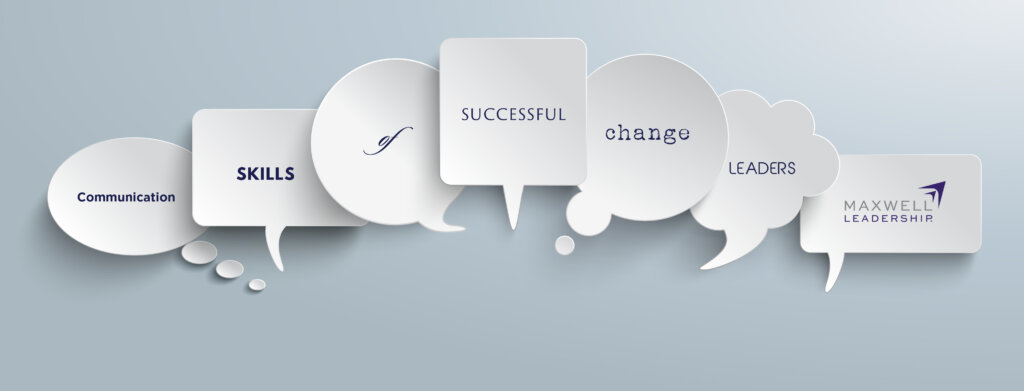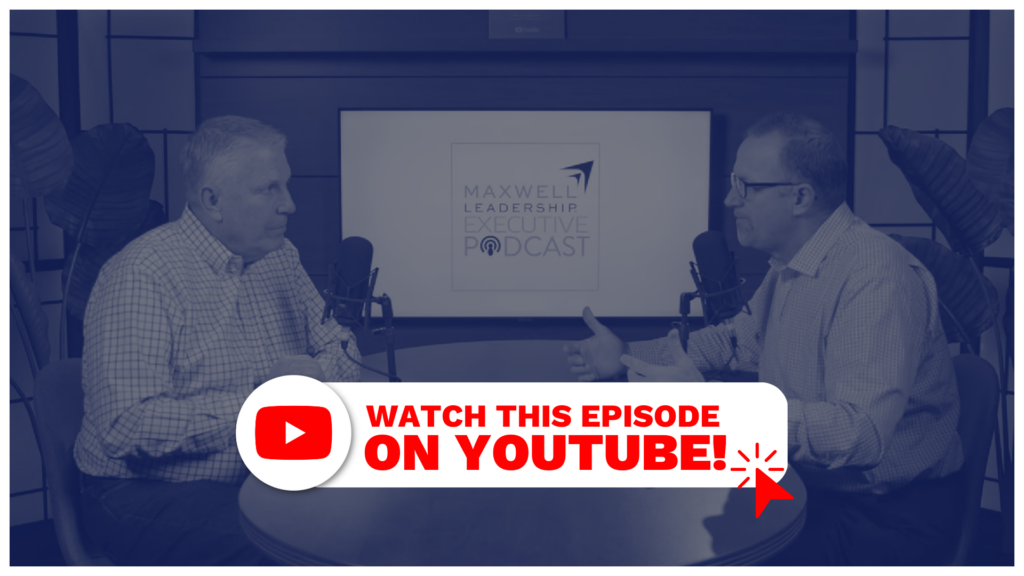Executive Podcast #281: Communication Skills of Successful Change Leaders

Successful change leaders communicate the vision of the future and involve employees in decision-making early on, strengthening their commitment to change. They also devote more of their own time to the change effort and focus on the big picture.
References:
Become a Maxwell Leadership Certified Team Member!
Register for Day to Grow on March 9th, 2024!
Download our Learning Guide for this podcast!
Perry Holley:
Welcome to the Maxwell Leadership executive podcast, where our goal is to help you increase your reputation as a leader, increase your ability to influence others, and increase your ability to fully engage your team to deliver remarkable results. Hi, I’m Perry Holly, a Maxwell leadership facilitator and coach.
Chris Goede:
And I’m Chris Goede, executive vice president with Maxwell Leadership. Welcome and thank you for joining. If you want to download the learner guide that we created for today’s lesson, I want to encourage you, go to maxwellleadership.com/podcast. There you can download that learner guide. You can click on this lesson. There’s a form there where you can leave us some information, or if you want information about some training or coaching for your team or your organization, don’t hesitate to do that. We would love to hear from you. Well, as we get started today, one of the topics that we always get asked about as we begin to work with organizations is, can you help us with communication? Well, we’re diving into change again and kind of staying on this theme, and we’re going to talk today about communication skills of successful change leaders.
Chris Goede:
Right. People that do change quite a bit go through it. And the ones that are successful, how do they communicate? What does that look like? And we know that poor communication is an issue, period. But as you lay out, maybe an impeccable plan for change, right? And you got this thing dialed in. We’ve talked about building a bridge. You got the plans laid out. All of that is great. You might know what you’re going to communicate and how you’re going to do it, but it’s going to get derailed.
Chris Goede:
And so what are some skills, what are some things as a successful communicator through change that you can learn? And so we’re going to just share some of that with you today.
Perry Holley:
I think it’s probably one of the, if not the key skill of most leadership is communication. How people, not necessarily what you said, but what they heard and how they receive. I thought I said that pretty clear. But we talk about the intention perception gap, where I intended it one way, people perceive it another. So I think in change, communication needs to go to another level. And we’ve kind of hit, over the previous weeks, as we’ve gone through the topics of change, we’ve hit a lot of these, but I really want to pull them together into one space. But before we go, I wanted to ask you, you’ve been leading for a while. You’ve led.
Perry Holley:
What’s your experience when you’re leading change? Have you seen bad and good communication. Have you personally experienced where you saw, man, I’m having a problem because of communication or it’s really working because of communication?
Chris Goede:
Yeah. I think for me it comes back to what we’ve built, really this podcast around and what you and I have given our time and our life to now with organizations is understanding the five levels of leadership and how that impacts your influence as a leader, but also the culture of the organization as we build a common language, which then leads to common behaviors at the end of the day, after they begin believing that that goes right with change as well. And I think about some bad experiences with communication of leaders, and it came from level one, which we’re going to talk about, just a dictatorship. It’s like we’re going to change, we’re going to do this, and then we walk out of the room. No. Any questions? Any thoughts? None of that stuff. Not that they would have gotten any at that point, but it is where, hey, man, this is how the other thing was that their behaviors were incongruent with what they were saying and the communication of what they were telling us the change was and how excited they were about it. But their behaviors as a leader was the opposite of that.
Perry Holley:
That’s big.
Chris Goede:
And so those two things just stick in my mind about that didn’t go well, and then just the opposites of those are the things that would go well. Yeah.
Perry Holley:
I reported to the CEO once, and it was one of his great mentoring moments with me was we go into the senior executive room and we were making decisions. We’re going to make some Ross the board change or something. And he said, now let’s debate it. Be aggressive. You can disagree, you can dissent. Let’s knock it around in here. But when we leave, you don’t have to be in agreement, but you have to be in alignment. And I thought, why is he harping on this? Because what was happening was we were going out individually and we’re kind of looking at our team and saying, I don’t really believe in this, but we got to do it.
Perry Holley:
And I thought, now I’m not in alignment with it just because I wasn’t fully bought in, I’m now out of alignment. And it’s making the CEO look bad like it makes me look bad. And by the way, the team is now going to feel I’ve just given them the ticket to resist because you don’t even like it, period.
Chris Goede:
So you are a poor communicator in that process because of the way you’re going about it.
Perry Holley:
Yes, coming out of it, just when we go into a change, I’ve had my voice in it and whether I like it or not, I’m in alignment and we’re going to do this and I’m going to put the appropriate energy with it when I begin my communication and not, we got to do this. No, I’m going to, hey, we got this opportunity and you’re going to get pushback. But they have to thought about that. But I would say the first two, I got just a number of ideas that I’ve been collecting and some of them are going to say very simple, but they’re not so easy. I found. And the first, I guess number one, communicating as early, I think we’ve hit that a few times. How much in front of the change can you get? And then often keeping that consistent message going. So a little drumbeat around the change that’s coming and then clarity.
Perry Holley:
I would probably be number two so early and often be number one, and then clarity would be number two again. Those, Doug, we should do that, but what’s your thought? Where do we get that? Seems so simple, but where do we come off the rails with that?
Chris Goede:
Your team, those that you have influence with, they need to hear your voice often, period. Right. We always encourage our leaders to have routine one on ones and team meetings, and they’ve got to hear the voice from the leader. It’s even more important as you’re communicating through change that they hear your voice and they hear it often. And then the other thing I’ll talk about around clarity is that this is a big thing for us that we talk about. Maxwell leadership quite a bit, because John is a leader that sees all kinds of opportunities to add value to people. We may be extremely uncertain on how we’re going to get there, but we’re very clear on what we need to go do right, what the mission is. And so one of the things I think you can do to communicate successfully as you’re going through change and Perry talked about is clarity.
Chris Goede:
But I like to say, hey, make sure you are communicating with clarity, not necessarily certain that you probably don’t have it, and then give them space for just a little bit, because what you want them to do is you want them to process it. They’re all going to process it a little bit differently. You want them to begin to adapt to it, and then you want to recircle back and then have a which. But again, that goes back into the fact that they’re hearing your voice often. So be clear, even though you may not be certain, and then give them a little bit of space to react and then come back in again and making sure that you’re communicating often because they need to hear your voice. The other thing, too, is that I jot down here was the more you can communicate in stories to them.
Perry Holley:
What a great ad.
Chris Goede:
Yeah, the stickier. We were just talking about being sticky. When you’re communicating the stories of kind of where we’re going and why we’re going, and maybe if you have examples of other people that have made that change and you’re communicating that they can begin to see that they can begin to paint that picture in there. And so that’ll make it even more clear in their mind when they hear those stories from went.
Perry Holley:
When you said that about the stickiness of a story, I heard Andy Stanley say that he gets these concise ways of communicating what he wants, but it makes it portable. I didn’t add that to our list. Is your message portable? Can people on your team carry it to other people on the team? Is it so complex and so unclear that we’re just got to go take step a? No, they know the big picture. Do they carry it? And that you hear them sharing it with someone else. I mean, make an ad here.
Chris Goede:
No, I like that. Right, because we always talk about, are you carrying the message? But I like how you’re saying is, have we created to be portable enough for our team to be able to carry it and to pass it on? And that’s the key. You’ve got to be able to do that. So I like that. Goede.
John Maxwell:
Hey, John Maxwell here. I’m in the studio. We’ve been recording all day, and I was thinking about, really, one of my very favorite experiences that we have, and that is called day to grow.
Chris Goede:
If you want to grow, you want.
John Maxwell:
To grow in every area of your life. I tell people all the time, you don’t want to go to something. You want to grow to something. But if you’re passionate about personal growth, development your team, and growing them, you do not want to miss day to grow. I’m going to have some real players with me, Dion Sanders, Jamie Kern, Lima, myself. Oh, my gosh. You don’t want to miss it. So, market, come and see us on day to grow.
John Maxwell:
I will promise you this. You come and bring your team. At the end of the day, you’ll come up and shake my hand and say, one of the best days I’ve ever invested in for myself and for my team. I’ll see you there.
Perry Holley:
A third way. And this is, again, sounds simplistic, but I’ve been asking people as I’m teaching, what is the problem? And is that inconsistency? So are you communicating with consistency? And when I think about that, I go, I don’t think there’s a leader on the planet that would say, yeah, I was purposely trying to be inconsistent and like, no, you’re not, but what do we do? It’s wondering what your opinion is on that. What would inconsistent communication around change be?
Chris Goede:
So for me, that would be oftentimes when people say, well, you’ve gone silent. Where have you been? Haven’t seen you in a while, haven’t heard from you. And the way to overcome this for me has been in the past because we all have a lot of things on our plate. We’ll all get distracted. And by the way, normal business is still running and expectations are still expected. KPIs and also while you’re going through this change, so you’re going to get distracted. And so one of the things that I was thinking about here was there’s no doubt that consistency compounds. We talk about that as a theme in one of John’s statements.
Chris Goede:
And so we’ve got to make sure that we are consistently and consistency is showing up as we communicate the message. What the message is is consistent and we’re doing it consistently. But on the front end of this change, as you know it’s coming down, you begin to think about how you’re going to communicate it. Develop a change communication plan. Now, that’s not something that needs to be complex. I would even get down and say, well, who are your key stakeholders that are going to take that message you talked about from Andy and carry it for us? And it’s portable. Who are the key stakeholders and then what are the communication channels that we’re going to use and what’s the frequency of communication? Because I can then keep those three things in front of me and I can be on a Friday going, oh, I was supposed to send out an email this morning with an update on the change of what has happened to these three stakeholders and I didn’t do that yet, versus going, yeah, you know what, I’m going to communicate often to you. Well, I’m going to have good intentions, but we know what they say about the road of good intentions.
Chris Goede:
So just make sure that it doesn’t have to be complicated. Develop a simple communication plan that as you’re going through this change, you can stick to as the leader.
Perry Holley:
It’s not in the lesson here today. It’s using different modalities. You said, I’m going to send an email thinking most people think about change. It’s at the team meeting. It’s on the Zoom call. But are you using all the modalities you could be using? Do you update them through email? Do you maybe have a text stream that’s going with your team? Do you maybe have a weekly team meeting that you might use a Zoom? Can you leave a voicemail for the team and let them know so you’re using different modes instead of everything for me is face to face or over the zoom? No, I’m continuing and consistently. My message is coming around. Here’s what we’re seeing, here’s how we’re doing.
Perry Holley:
Here’s a milestone, here’s a celebration, here’s a reward. All that’s keeping that consistency in front of us. Next one. I know we talked about it last week, and you make fun of me for the FM radio, but everybody’s tuned to the same channel, WiiFM, and it’s what’s in it for me. So I’d have to say number four is, are you answering the what’s in it for me question in your communication? And I’ll just add to that. Maybe number five kind of goes with that, acting with empathy. And I really would love your thoughts on that. I definitely want to take the what’s in it for me? Question.
Perry Holley:
It’s got to be answered in all my communication because people are thinking that immediately, how’s this affecting me? And then you think, are they going to make a bad decision? So can I help them know why it’s affecting them? But then where does empathy come in as well?
Chris Goede:
Well, if my wife is listening to this podcast, this may not come across right. I’ll hear about it. She’ll be like you and Perry were talking the other day, and I don’t think that’s true. And I know I make fun of the FM radio. I mean, it goes right along with earth, wind and fire, which, by the way, if you missed that episode, I want to encourage you to go back. That came back up several episodes ago where Perry and I talked a little bit about some of his favorite music on the FM radio. When you think about empathy, here’s what I’ll tell you. When you go through change, this is the first thing I thought about was oftentimes, because they think about how it’s going to affect them, they take it personal.
Chris Goede:
Your team does, you do as well, and that’s going to have a cause to deteriorate a little bit of trust that they may have with you, right? And they go, do I really trust Chris in this process? Does Chris believe in this? Is Chris just doing this? Because whatever, all that’s going to naturally happen? And so I think that when you get into the boat of empathy and understanding, those are the first steps to rebuilding that trust. So, remember, when the change comes down and you begin to communicate it, your trust may take, depending on where you’re at, levels of influence. We’re not going to talk about that right here, but you may lose a little bit of trust. And so you’ve got to empathize and have understanding immediately with where they’re at, because that’s the first couple of steps of rebuilding trust. The other thing is that how do you put yourself in their shoes? You have the privilege of probably knowing a little bit more than they do. You probably have a longer view of things than they do, and how do you remove all of that, and then you put yourself in their shoes and say, okay, if I was Perry in this situation, I could see how I’d feel that way. The understanding, the empathy comes in, and then you begin to rebuild that trust. What I want to caution you right here, though, is I want to make sure that, as Perry was mentioning a little bit earlier, with the agreement and the alignment, what I want to make sure is that you don’t get in a position to where you’re empathizing with them in regards to them resisting the change.
Perry Holley:
Right?
Chris Goede:
Yeah.
Perry Holley:
Good.
Chris Goede:
That’s a dangerous place to go. And as you’re communicating this, you need to make sure you don’t begin communicating with them in that boat, because that’s not the right boat that you want to be in, but you do want to empathize on where they’re at. And you put yourself in their shoes and let them be heard, let their voice be heard about what they feel and think about the change.
Perry Holley:
A lot to be said for knowing the people in your team really well and how they handle things and how they’re going to see things and what they struggle with and where their strengths are and struggles might be so that you’re prepared for that kind of leads to one we talked about last week quite a bit, but I think about resistance is that we said last week, you’re going to have it. Don’t take it personal, but I wondered if what your thoughts were in your communication plan and how you communicate, is there a way to help head off, reduce, minimize resistance so that it doesn’t blow up a change effort no.
Chris Goede:
Here’s what I wrote down as I was thinking about that. You’re going to get resistance. We’ve talked about that, so expect it. You want to minimize it. When you get resistance, that means you probably did a pretty good job of communicating the change because you got the resistance. They pulled back. You pulled back whatever it might be. But maybe, perhaps you didn’t do such a good job with creating the buy in from the people or getting the felt need across to them on the importance of this change goes into the why goes into the bigger picture and all that kind of stuff.
Chris Goede:
And so again, as we’re communicating, this is what we’re talking about. How do you communicate? Well, through change. Don’t just go communicate the change that’s going to create resistance. You’ve got to communicate the change. But then you also got to communicate in a way that you get their buy in and that they understand and are part of the felt need for that change.
Perry Holley:
Fantastic. Well, last two that I thought in my communication efforts that I’ve seen really work was just evangelizing a bit of the positive and the energy that you bring to that. And then we mentioned just briefly last week about being present. Did you just throw it over the wall and disappear, or are you a part of this? Are you involved or are you checking through? And it goes back, maybe that consistency thing, but evangelizing the future about why are we doing this? What’s the big picture and where we’re going and being present.
Chris Goede:
The word evangelize means to convert, right? And so I love that you threw this in here because how do we convert the way that we go about thinking right now? Because to a man, we could sit here and say, we probably think that in five years we’re going to be sitting here doing this podcast just like this, right? So that’s not real, but our mind thinks that way, that what we do today we’re going to always be doing for most of us. And so how do we convert them to understand and us to understand that we will become irrelevant if we don’t go through that change process. So I love the word that you used here with evangelize because that’s what we’ve got to think about is how do we convert what we’re doing now or where they’re at now with the announcement of the change that we’re communicating and how do we get them to the future? How do we evangelize it? How do we convert them to understanding that in our communication? Remember, we’re talking about doing this through communication. And so I think that’s a key word. And how do we begin to think about that before we even communicate to them? The other thing is about being present. I love what you said just a few minutes ago. There are many different modes of communication. And nowadays I would encourage us around be present is that they do see your face when you’re communicating.
Chris Goede:
Not just an email, not just a voice text, not just a voicemail. And so I think that that allows you to be present with them and that they know that you’re in it with. Well, as we wrap up and remember, we’re talking about communication skills of a successful change leader wrote down a few things. Excellent communication through change can do a couple of the following, which is why Perry brought this lesson to us, because I think the outcome of communicating well could be these. You’re going to help reduce resistance. That’s kind of been a theme we’ve been talking about. You’re going to be able to rally the team. There’s going to be a rallying cry of the network of your team to be able to support that change if you can do it well.
Chris Goede:
And then finally you’re going to be able to provide info, information for people to change effectively. If you don’t communicate, they will change, but maybe not effectively and maybe not in the right way. And so remember, communication has a greater purpose beyond just creating a simple awareness. If you remember that statement, we’re not just trying to make them aware of the change. There’s a greater purpose to why and how we’re communicating. Our team, communicating with our team through change. And you’ve got to keep that in mind because it’s not you just coming in and reading off the notes. All right, welcome to class today.
Chris Goede:
Here’s the change. We’re now going to lunch at 1145 instead of twelve, which, by the way, I would have checked out. I would have resisted when I was in school. No, you need to have a greater awareness of the power of that communication through change.
Perry Holley:
Super. Well, I, by the way, evangelizing the future on this podcast. I see us in five years in Las Vegas in a show, but I.
Chris Goede:
Don’T like it on stage in the show sold out.
Perry Holley:
But another thing I learned today is that I don’t need to bring that lesson. I was going to bring on the carpenter’s music. I’m kidding. Earthwind in front. That was a great episode. I can’t believe you’re still hanging on to that. All right, thank you for great insights and thank you all for joining us. If you want more on the learner guide for this, learn more about our offerings, about the five levels of leadership, about other podcasts in our podcast family.
Perry Holley:
If you’d like to leave us a comment or a question, we love hearing from you. Very grateful you spend this time with us. And that’s all today from the Maxwell Leadership executive podcast.
To be a Successful Leader, You Need Feedback on Your Leadership.
We’re excited to announce our new and improved Organizational Effectiveness Survey (OES). The OES gathers feedback from employees to give leaders and management the knowledge and action plans needed to develop a more effective and productive work environment. Our new version measures 4 areas of your business: Leadership, People, Strategy, and Performance.













Be the first to comment on "Executive Podcast #281: Communication Skills of Successful Change Leaders"